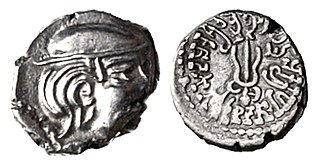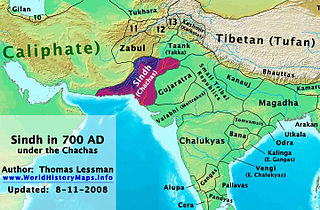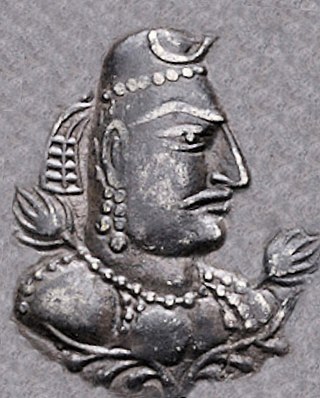The Gupta Empire was an ancient Indian empire on the Indian subcontinent which existed from the early 4th century CE to early 6th century CE. At its zenith, from approximately 319 to 467 CE, it covered much of the Indian subcontinent. This period has been considered as the Golden Age of India by historians, although this characterisation has been disputed by some other historians. The ruling dynasty of the empire was founded by Gupta and the most notable rulers of the dynasty were Chandragupta I, Samudragupta, Chandragupta II, Kumaragupta I and Skandagupta. The 4th-century CE Sanskrit poet Kalidasa credits the Guptas with having conquered about twenty-one kingdoms, both in and outside India, including the kingdoms of Parasikas, the Hunas, the Kambojas, tribes located in the west and east Oxus valleys, the Kinnaras, Kiratas, and others.

The middle kingdoms of India were the political entities in the Indian subcontinent from 230 BCE to 1206 CE. The period begins after the decline of the Maurya Empire and the corresponding rise of the Satavahana dynasty, starting with Simuka, from 230 BCE. The "middle" period lasted for almost 1436 years and ended in 1206 CE, with the rise of the Delhi Sultanate, founded in 1206, and the end of the Later Cholas.

The Gurjara-Pratihara was a dynasty that ruled much of Northern India from the mid-8th to the 11th century. They ruled first at Ujjain and later at Kannauj.

The following outline is provided as an overview of and topical guide to ancient India:

The Maitraka dynasty ruled western India from approximately 475 to approximately 776 CE from their capital at Vallabhi. With the sole exception of Dharapaṭṭa, who followed the Mithraic mysteries, they were followers of Shaivism. Their origin is uncertain but they were probably Chandravanshi Kshatriyas.
Nagabhata II was an Indian Emperor from Gurjara-Pratihara dynasty. He ascended the throne of Gurjara-Pratihara dynasty after his father Vatsraja. His mother was queen Sundari-Devi. He was designated with imperial titles - Paramabhattaraka, Maharajadhiraja, and Paramesvara after conquest of Kannauj.

Jainism has had a notable following in Gujarat. According to the 2011 Census of India, around 0.959% of the population of Gujarat is Jain. There are several old Jain temples that draw pilgrims from Jains around the world in places such as Palitana, Taranga, Sankheshwar, Idar.

The Umayyad Dynasty came to rule the Caliphate in 661 CE, and during the first half of the 8th century CE, a series of battles took place in the Indian subcontinent between armies of the Umayyad Caliphate and Indian kingdoms situated to the east of the Indus river, subsequent to the Arab conquest of Sindh in present-day Pakistan during 711 – 713 CE.

The history of human settlement in the western Indian state of Rajasthan dates back to about 100,000 years ago. Around 5000 to 2000 BCE many regions of Rajasthan belonged as the site of the Indus Valley Civilization. Kalibangan is the main Indus site of Rajasthan, here fire altars have been discovered, similar to those found at Lothal.

The Paramara Dynasty ruled Malwa and surrounding areas in west-central India between 9th and 14th centuries. They belonged to the Parmara clan of the Rajputs.

The Tripartite Struggle, also known as The Kannauj Triangle Wars, for control of northern India took place in the ninth century, among the Gurjara-Pratihara Empire, the Pala Empire and the Rashtrakuta Empire.
The Gurjaras of Lata, also known as Gurjaras of Nandipuri or Bharuch Gurjaras, was a dynasty which ruled Lata region as a feudatory of different dynasties from c. 580 CE to c. 738 CE.

The Chudasama dynasty, a Samma branch, ruled parts of the present-day Saurashtra region of Gujarat state in India between the 9th and 15th centuries. Their capital was based in Junagadh and Vamanasthali.
Vindhyavarman was an Indian emperor from the Paramara dynasty, who ruled in the Malwa region of central India. He defeated the Chaulukyas, who had annexed the Paramara territory to their own kingdom in the preceding years.

The Gupta era is a historical calendar era that begins from c. 318–319 CE. It was used by the Gupta emperors, as well as their vassals and their successors in present-day northern India and Nepal. It is identical to the Vallabhi era, which was used in the Saurashtra region of western India, although regional differences lead to a slightly different calculation for the conversion of Vallabhi era years to Common Era (CE).

The Saindhavas, also known as Jayadrathas, was a Medieval Indian dynasty that ruled western Saurashtra from c. 735 CE to c. 920 CE, probably in alliance with Maitrakas in its early years. Their capital was at Bhutamabilika. The known historical events during their rule are the attacks of Arabs repulsed by Agguka I.

The Alchon Huns, also known as the Alkhan, Alchono, Alxon, Alkhon, Alakhana, and Walxon, were a nomadic people who established states in Central Asia and South Asia during the 4th and 6th centuries CE. They were first mentioned as being located in Paropamisus, and later expanded south-east, into the Punjab and Central India, as far as Eran and Kausambi. The Alchon invasion of the Indian subcontinent eradicated the Kidarite Huns who had preceded them by about a century, and contributed to the fall of the Gupta Empire, in a sense bringing an end to Classical India.
Shiladitya of "Mo-la-po" was a 6th-century king of India, known only from the writings of the 7th-century Chinese traveler Xuanzang. Several modern scholars identify this king as the Maitraka king Shiladitya I alias Dharmaditya, although alternative theories exist.















